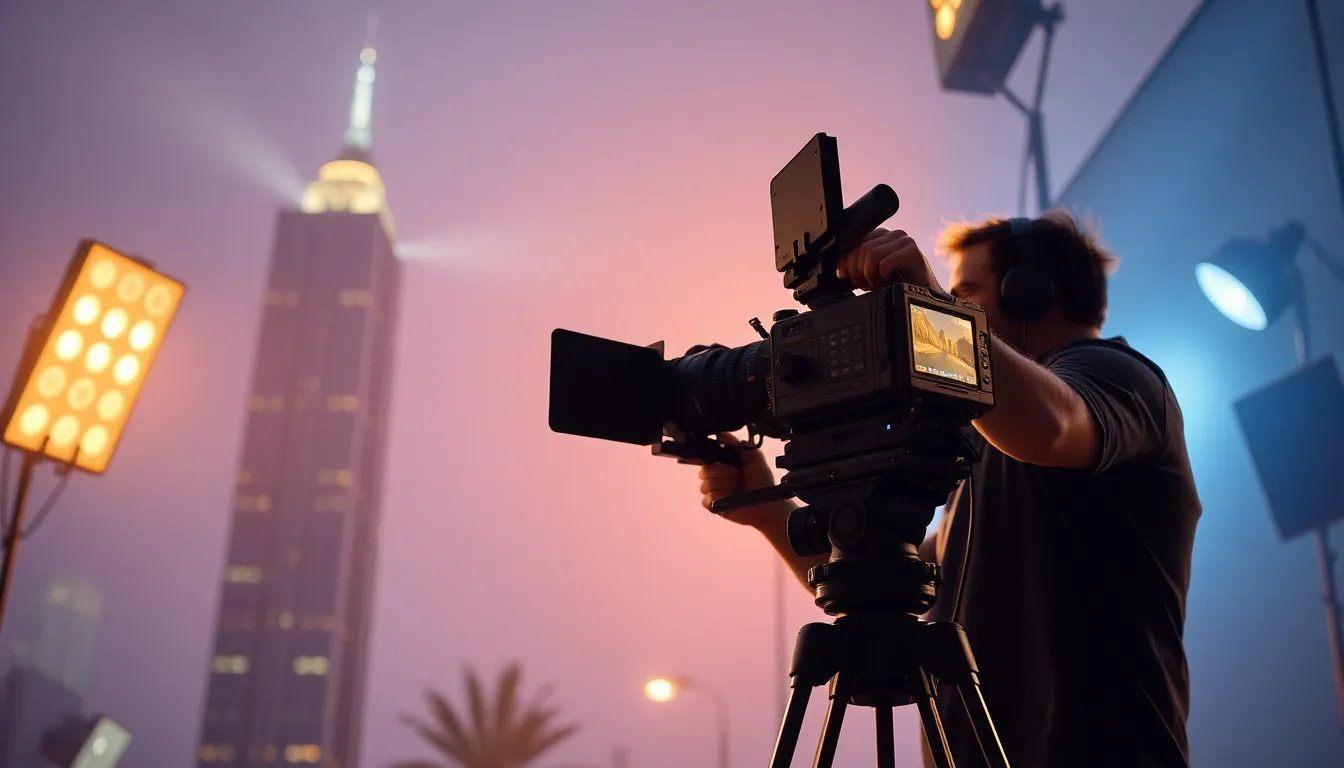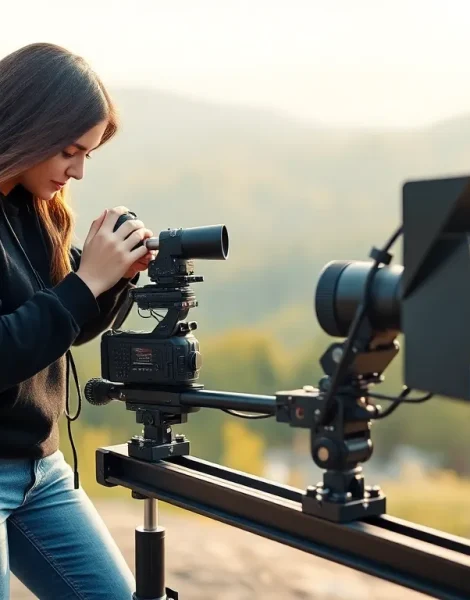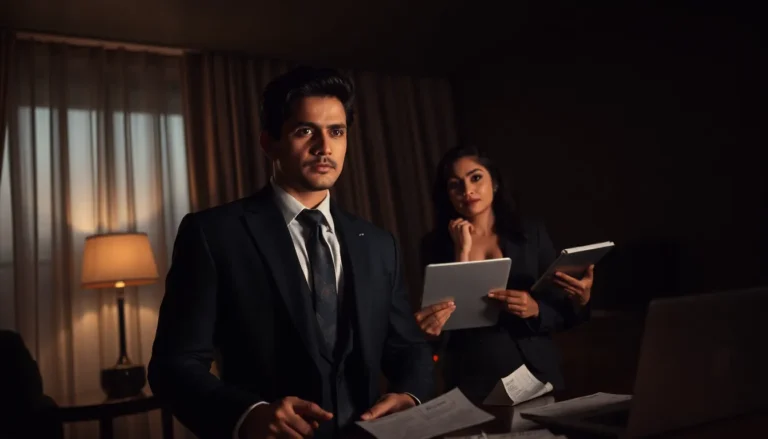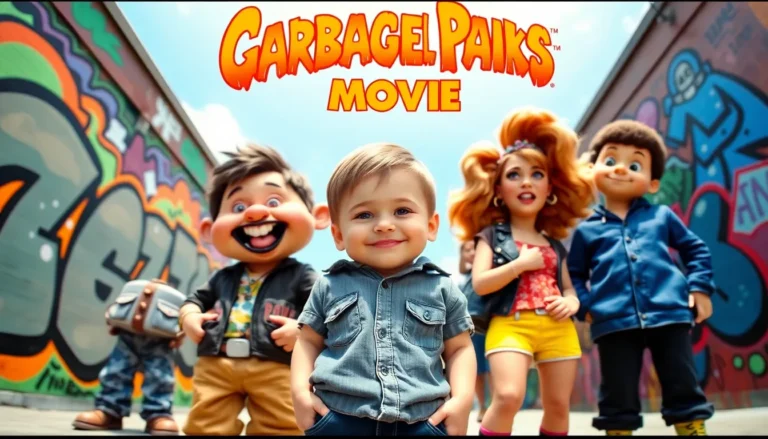Camera movement is the secret sauce that can turn a mundane scene into a cinematic masterpiece. It’s like giving your footage a shot of espresso—suddenly everything’s more dynamic and engaging. Whether it’s a smooth dolly in or a dramatic whip pan, each movement adds a layer of storytelling that can captivate audiences and elevate a simple video to art.
Table of Contents
ToggleWhat Is Camera Movement?
Camera movement refers to the techniques used to shift the camera’s position relative to the scene being filmed. This movement changes the viewer’s perspective, influencing how they interpret the story on screen. Different styles of movement, such as pans, tilts, dollies, and zooms, serve various narrative purposes.
Pans involve rotating the camera horizontally to follow an action or reveal new information. Tilts elevate or lower the camera’s angle, adjusting the viewer’s focus on subjects. Dolly shots create depth by moving the camera towards or away from a subject. A steady dolly in builds intimacy, while a dolly out often conveys a broader context.
Creative techniques like whip pans provide dramatic transitions between scenes. Quick camera movements can heighten tension or excitement. Smooth tracking shots immerse viewers in the environment, enhancing the overall cinematic experience.
Cinematographers often combine movements to craft effective storytelling. By utilizing a mix of techniques, they create dynamic visuals that resonate with audiences. Clear communication of emotions and themes becomes achievable with thoughtful camera movement. For instance, sudden jerky movements can evoke chaos, while slow, deliberate tracking shots suggest calm.
Understanding these aspects of camera movement fosters better appreciation for film and video production. Ultimately, camera movement plays an essential role in shaping narratives, turning mundane moments into powerful cinematic experiences.
Types of Camera Movement

Camera movement encompasses various techniques that enhance storytelling through visual dynamics. Each method serves a unique purpose, influencing viewer perception and narrative engagement.
Panning
Panning involves rotating the camera horizontally. This technique effectively follows moving subjects or reveals new elements in the scene. It creates a sense of continuity, guiding viewers’ eyes across the action. A fluid pan can maintain narrative flow while drawing attention to essential details. Commonly used in interviews, panning helps keep the focus on the speaker or the surrounding environment. Fast pans can convey urgency, while slow pans allow for a more deliberate examination of the setting.
Tilting
Tilting refers to adjusting the camera’s angle vertically. Cinematographers often use this technique to highlight a subject’s height or to provide a broader view of a location. Tilting adds depth to a scene, enriching visual storytelling. Viewers experience a unique perspective when the camera tilts upward toward tall structures or downward toward grounded elements. This movement encourages an emotional response, whether it emphasizes grandeur or vulnerability. Used effectively, tilting enhances the dramatic tension and supports thematic elements.
Tracking
Tracking involves moving the camera alongside a subject. In this dynamic movement, the camera follows action, creating a sense of immersion. It allows viewers to feel as if they are part of the scene, enhancing emotional connection. Smooth tracking shots can build suspense or reveal critical information at pivotal moments. Cinematographers use tracking to cover extensive distances or to capture intricate details within a moving environment. This technique seamlessly integrates action and setting, elevating the overall cinematic experience.
Zooming
Zooming alters the focal length of the lens to magnify or diminish the subject. This method creates an intimate connection with characters or surroundings. A close zoom can accentuate emotions, while a wide zoom establishes context. Effective zooming provides additional layers of meaning, directing viewers’ focus where it matters most. Sudden zooms might heighten tension or surprise, while gradual zooms encourage reflection. Cinematographers utilize this technique to balance framing while enhancing narrative depth.
Dolly Shots
Dolly shots involve moving the entire camera on a wheeled platform. This movement creates smooth transitions between scenes, delivering a cinematic quality. With dolly ins, feelings of intimacy develop as the camera approaches a subject. Conversely, dolly outs provide context by pulling back from the main action. Creating depth, dolly shots engage viewers with continuous motion. This approach allows multiple layers of storytelling within a single shot, enhancing viewer immersion in the narrative.
Importance of Camera Movement
Camera movement plays a vital role in filmmaking, significantly influencing how audiences engage with a story.
Enhancing Storytelling
Various camera movements enrich storytelling. Smooth pans help to transition scenes, guiding viewers from one focal point to another. Tilts allow filmmakers to introduce or reveal characters and settings, adding layers to the narrative. Dynamic dolly shots deepen intimacy by inviting viewers closer to characters in critical moments. Creative techniques like whip pans offer surprising shifts, sustaining viewer interest. By thoughtfully selecting movements, filmmakers maximize storytelling potential, ensuring each shot contributes to a coherent narrative flow.
Creating Emotional Impact
Camera movement significantly creates emotional impact. When tracking moves alongside characters, it fosters a deeper emotional connection. Quick, abrupt movements can heighten tension and urgency, compelling viewers to feel the same anxiety as the characters. Conversely, slow and steady shots evoke calmness, allowing moments to resonate. By manipulating the camera, filmmakers can evoke specific feelings, providing a more immersive experience. Emotional landscapes emerge through well-chosen movements that articulate the underlying themes and character dynamics.
Establishing Pace and Rhythm
Establishing pace and rhythm is another essential aspect of camera movement. Quick cuts paired with rapid movements can create a sense of urgency and excitement. Conversely, extended shots with gentle movements can slow the narrative, inviting contemplation. Cinematographers often adjust camera speeds to match the story’s tone, ensuring a harmonious relationship between visuals and audio. As movements align with rhythm, they enhance the overall viewing experience, making the film’s flow more engaging. Effective pacing balances action and stillness, drawing viewers into the cinematic world.
Techniques for Effective Camera Movement
Camera movement techniques play a vital role in enhancing videography and storytelling. Various methods help convey emotions and narratives more effectively.
Smooth Transitions
Smooth transitions create fluid shifts between scenes. Employing gradual dolly ins engages viewers, drawing them into intimate moments. On the other hand, dolly outs can widen perspective, offering a broader context. Pans allow horizontal movement across a scene, revealing new elements without jarring cuts. Using these techniques maintains visual coherence, inviting audiences to stay immersed in the story. Properly executed transitions contribute to an effortless viewing experience, ensuring the audience follows character journeys seamlessly.
Using a Stabilizer
Stabilizers address the shakiness often present in handheld shots. This equipment allows for steady tracking, enhancing the overall quality of footage. Smooth tracking shots foster connection with the subject, amplifying emotional impact. Utilizing gimbals also helps maintain stability during movement, preventing distracting jitters. Filmmakers achieve cinematic quality by incorporating stabilizers, making it easier to convey complex narratives. By ensuring fluid camera work, they elevate the viewing experience, allowing stories to resonate more deeply with audiences.
Camera movement is a vital tool in filmmaking that shapes how stories are told and experienced. By mastering various techniques like pans, tilts, and dolly shots, filmmakers can create a rich visual language that captivates audiences. Each movement serves a purpose, enhancing emotional connections and guiding viewers through the narrative.
Incorporating smooth transitions and stabilizers further elevates the cinematic quality, ensuring that the audience remains engaged. Understanding and utilizing these camera movements not only enriches the storytelling process but also transforms ordinary scenes into memorable visual experiences. As filmmakers continue to explore innovative techniques, the impact of camera movement on storytelling will only grow, making it an essential focus for anyone passionate about video production.









